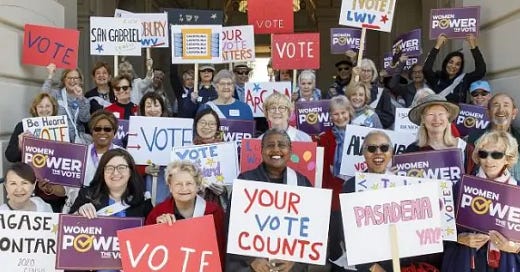The math has always been hard in the House. In the 2018 midterms, a Blue Wave that capitalized to a large extent on suburban white women’s strong dislike of Trump (on top of typical midterm losses for the party in power) handed Democrats a commanding House majority. That all but evaporated by 2020 as Trump voters turned out in force to push back, with only a very narrow House majority left for the Democrats. In 2022, we are balanced on that thin majority, which runs straight through districts that Joe Biden won in 2020–but by small enough margins, of around two percent, that a Red Wave could easily swamp them.
Balancing this out is the the hope that the GOP will face sizeable pushback in 2022 should women and young voters turn out in large numbers in protest over the Dobbs decision. That may be why the GOP believes its best hopes are in House races where the question of abortion isn’t squarely on the ballot. Tellingly, the Republican machine is now focusing much of its ad spend on blue state districts held by vulnerable Democratic incumbents, where women voters feel more secure about their reproductive rights. That has meant that other issues, such as inflation and crime, have risen higher in priority to those voters. So, could that GOP strategy work?
First, the Good News
We have seen a surge in younger, female voter interest play out in both the registration of new voters and requests for mail-in ballots in certain states, primarily where reproductive rights are threatened. According to data from TargetSmart, female voter registrations are outpacing male voter registrations, sometimes by at or near double digits, in crucial states like Michigan and Wisconsin. The figures are an indication that there is indeed a gender enthusiasm gap that favors Democrats in those states, which could result in repercussions in key governor and senate races there.
This surge in interest has also shown up in the share of vote-by-mail requests by women, which has increased sharply in certain states over 2020 levels. In its analysis of seven states back in September, TargetSmart calculated that the increase in share ballot requests by women is on average an increase of 2 percent over men compared to 2020 levels. Assuming these are pro-abortion rights voters, that could be enough to tip the scales in certain races.
Now, the Bad News
While this enthusiasm gap is palpable in the swing states, in blue enclaves like the state of New York, where reproductive rights are guaranteed, there has been only a very small uptick in women voters’ share of the new registrations. And in Illinois, where abortions are also legal and accessible, there was a drop in new vote-by-mail requests compared to 2020, even while interest surged in more competitive states.
But why does this matter? Aren’t the blue states, well, blue?
What most voters don’t realize is that control of the House runs straight through the blue states like New York, California, and Oregon, among others. Of the 31 races considered toss-ups by the Cook Political Report, 23 are in states won by Biden in 2020. If you add in the “lean” races, of the 59 races considered fairly competitive, 44 of them are in the blue states won by Biden. These swing districts hold the key to the House, but the problem is, most of the seats are held and being defended by Democrats.
By my unscientific count, some 31 key House races are in districts that are unlikely to get much of the Dobbs enthusiasm bounce, precisely because voters there think the right to abortion is not at risk for them or their families. Republicans don’t have to win many of these to flip control of the chamber.
So What Do We Do?
Voters in blue states, particularly young people, need to realize that if the GOP candidates running in swing districts in their states win, and control of the House shifts because of it, this will breathe instant life into a national abortion ban. There is no safe place now that the federal government, when controlled by the Republicans, intends to supersede state law. (All that talk about letting the states decide turns out not to be true once the GOP is in power nationally.) Further, if we want any chance of codifying the abortion rights protections of Roe, we need a Democratic House majority to do so. This will come down to messaging in the blue states in these final weeks where Democrats are playing defense.
The GOP is betting that suburban voters in 2022 will care more about inflation and crime than democracy and bodily autonomy and will vote accordingly. If you live in a blue state, consider donating or volunteering for a close House race in your own backyard. You can see a handy list of the toss-up districts in the gray columns here:
https://www.cookpolitical.com/ratings/house-race-ratings





I'm working as a polling judge in my district of Southern Illinois & voted early on the 13th after polling training. My area is typically very, very red, but I've noticed a trend I've not seen in years, with yard signs. I'm seeing many more democratic candidates' signs and that is definitely heartening, but I'm still concerned. I try talking with younger voters and expressing how important it is for them to vote and let them know what's at stake. Fingers crossed 🤞 they understand and are ready to participate in our democratic process! 🥰 Thanks, as always, Jay, for your insight!
It’s hard not to be afraid. Yet, we press on.